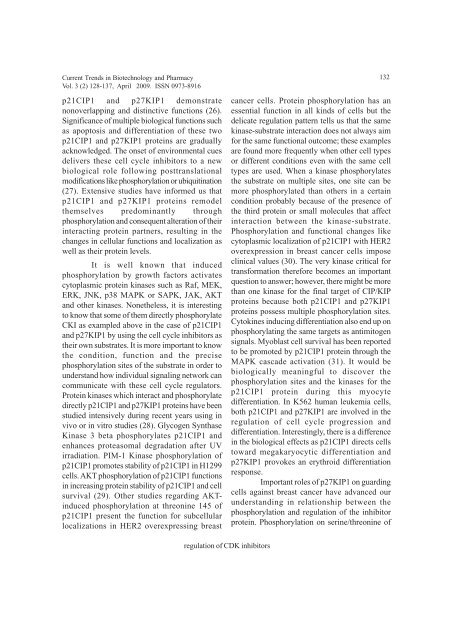April Journal-2009.p65 - Association of Biotechnology and Pharmacy
April Journal-2009.p65 - Association of Biotechnology and Pharmacy
April Journal-2009.p65 - Association of Biotechnology and Pharmacy
Create successful ePaper yourself
Turn your PDF publications into a flip-book with our unique Google optimized e-Paper software.
Current Trends in <strong>Biotechnology</strong> <strong>and</strong> <strong>Pharmacy</strong><br />
Vol. 3 (2) 128-137, <strong>April</strong> 2009. ISSN 0973-8916<br />
p21CIP1 <strong>and</strong> p27KIP1 demonstrate<br />
nonoverlapping <strong>and</strong> distinctive functions (26).<br />
Significance <strong>of</strong> multiple biological functions such<br />
as apoptosis <strong>and</strong> differentiation <strong>of</strong> these two<br />
p21CIP1 <strong>and</strong> p27KIP1 proteins are gradually<br />
acknowledged. The onset <strong>of</strong> environmental cues<br />
delivers these cell cycle inhibitors to a new<br />
biological role following posttranslational<br />
modifications like phosphorylation or ubiquitination<br />
(27). Extensive studies have informed us that<br />
p21CIP1 <strong>and</strong> p27KIP1 proteins remodel<br />
themselves predominantly through<br />
phosphorylation <strong>and</strong> consequent alteration <strong>of</strong> their<br />
interacting protein partners, resulting in the<br />
changes in cellular functions <strong>and</strong> localization as<br />
well as their protein levels.<br />
It is well known that induced<br />
phosphorylation by growth factors activates<br />
cytoplasmic protein kinases such as Raf, MEK,<br />
ERK, JNK, p38 MAPK or SAPK, JAK, AKT<br />
<strong>and</strong> other kinases. Nonetheless, it is interesting<br />
to know that some <strong>of</strong> them directly phosphorylate<br />
CKI as exampled above in the case <strong>of</strong> p21CIP1<br />
<strong>and</strong> p27KIP1 by using the cell cycle inhibitors as<br />
their own substrates. It is more important to know<br />
the condition, function <strong>and</strong> the precise<br />
phosphorylation sites <strong>of</strong> the substrate in order to<br />
underst<strong>and</strong> how individual signaling network can<br />
communicate with these cell cycle regulators.<br />
Protein kinases which interact <strong>and</strong> phosphorylate<br />
directly p21CIP1 <strong>and</strong> p27KIP1 proteins have been<br />
studied intensively during recent years using in<br />
vivo or in vitro studies (28). Glycogen Synthase<br />
Kinase 3 beta phosphorylates p21CIP1 <strong>and</strong><br />
enhances proteasomal degradation after UV<br />
irradiation. PIM-1 Kinase phosphorylation <strong>of</strong><br />
p21CIP1 promotes stability <strong>of</strong> p21CIP1 in H1299<br />
cells. AKT phosphorylation <strong>of</strong> p21CIP1 functions<br />
in increasing protein stability <strong>of</strong> p21CIP1 <strong>and</strong> cell<br />
survival (29). Other studies regarding AKTinduced<br />
phosphorylation at threonine 145 <strong>of</strong><br />
p21CIP1 present the function for subcellular<br />
localizations in HER2 overexpressing breast<br />
132<br />
cancer cells. Protein phosphorylation has an<br />
essential function in all kinds <strong>of</strong> cells but the<br />
delicate regulation pattern tells us that the same<br />
kinase-substrate interaction does not always aim<br />
for the same functional outcome; these examples<br />
are found more frequently when other cell types<br />
or different conditions even with the same cell<br />
types are used. When a kinase phosphorylates<br />
the substrate on multiple sites, one site can be<br />
more phosphorylated than others in a certain<br />
condition probably because <strong>of</strong> the presence <strong>of</strong><br />
the third protein or small molecules that affect<br />
interaction between the kinase-substrate.<br />
Phosphorylation <strong>and</strong> functional changes like<br />
cytoplasmic localization <strong>of</strong> p21CIP1 with HER2<br />
overexpression in breast cancer cells impose<br />
clinical values (30). The very kinase critical for<br />
transformation therefore becomes an important<br />
question to answer; however, there might be more<br />
than one kinase for the final target <strong>of</strong> CIP/KIP<br />
proteins because both p21CIP1 <strong>and</strong> p27KIP1<br />
proteins possess multiple phosphorylation sites.<br />
Cytokines inducing differentiation also end up on<br />
phosphorylating the same targets as antimitogen<br />
signals. Myoblast cell survival has been reported<br />
to be promoted by p21CIP1 protein through the<br />
MAPK cascade activation (31). It would be<br />
biologically meaningful to discover the<br />
phosphorylation sites <strong>and</strong> the kinases for the<br />
p21CIP1 protein during this myocyte<br />
differentiation. In K562 human leukemia cells,<br />
both p21CIP1 <strong>and</strong> p27KIP1 are involved in the<br />
regulation <strong>of</strong> cell cycle progression <strong>and</strong><br />
differentiation. Interestingly, there is a difference<br />
in the biological effects as p21CIP1 directs cells<br />
toward megakaryocytic differentiation <strong>and</strong><br />
p27KIP1 provokes an erythroid differentiation<br />
response.<br />
Important roles <strong>of</strong> p27KIP1 on guarding<br />
cells against breast cancer have advanced our<br />
underst<strong>and</strong>ing in relationship between the<br />
phosphorylation <strong>and</strong> regulation <strong>of</strong> the inhibitor<br />
protein. Phosphorylation on serine/threonine <strong>of</strong><br />
regulation <strong>of</strong> CDK inhibitors













